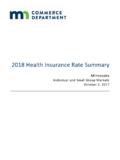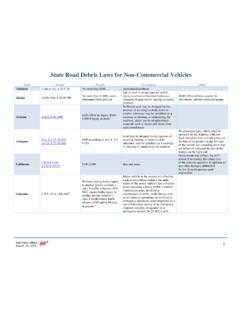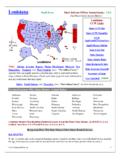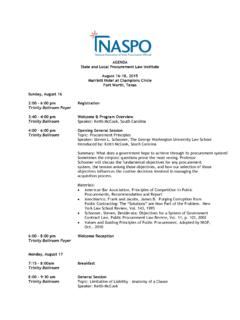Transcription of MINNESOTA LAW SUMMARY - Attorneys at Law
1 MINNESOTA LAW SUMMARY 8519 Eagle Point Boulevard, Suite 100 Lake Elmo, MINNESOTA 55042 651-290-6500 / 651-223-5070 (fax) MINNESOTA SUBSTANTIVE LAW Jardine, Logan & O'Brien, 8519 Eagle Point Boulevard, Suite 100 Lake Elmo, MN 55042 (651) 290-6500 Issues Details & Court Case / Statute Cite Statute of Limitation Personal Injury Property Damage Wrongful Death Professional Negligence Contract UIM/UM Claims Government Entities Statute of Repose Product Liability Construction Warranties Personal Injury: 6 years. Minn. Stat. , subd. 1 (5). Injury to Property: 6 years. Minn. Stat. , subd. 1 (4). Wrongful Death: 3 years. Minn. Stat. , subd.
2 1. Professional Negligence Resulting in Death: 3 years from the date of death. Minn. Stat. , subd. 1. Contract: 6 years. Minn. Stat. , subd. 1 (1). Uninsured Motorist: 6 years from the date of the accident. Weeks v. Am. Fam. Ins. Co., 580 24 (Minn. 1998). Underinsured Motorist: 6 years. Does not run from the date of the accident, rather, from the date of the settlement or judgment against the tortfeasor. Oanes v. Allstate Ins. Co., 617 401 (Minn. 2000). No-Fault PIP: 6 years from the date the cause of action accrues. May include a coverage provision terminating eligibility for benefits after a prescribed period of lapse of disability and medical treatment, which period shall not be less than 1 year.
3 Entzion v. Illinois Farmers Ins. Co., 675 925 (Minn. Ct. App. 2004). Claim against Government Entity: 180 days after the alleged loss or injury is discovered. Must submit a notice stating the time, place and circumstances, the names of any government employees known to be involved, and the amount of compensation or other relief demanded. Minn. Stat. , subd. 5. A municipality shall be liable only in accordance with the applicable statute and where there is no such statute, every municipality shall be immune from liability. Minn. Stat. , subd. 1. 2 Jardine, Logan & O'Brien, 8519 Eagle Point Boulevard, Suite 100 Lake Elmo, MN 55042 (651) 290-6500 Declaratory Actions: There is no statute of limitations for declaratory judgment actions.
4 State v. Joseph, 622 358 (Minn. Ct. App. 2001). Indemnity Actions for Improvement to Real Property: Actions may not be brought more than two years from the accrual of the cause of action. Cause of action accrues upon payment of the final judgment, arbitration award, or settlement arising out of the unsafe and defective condition. Minn. Stat. , subd. 1(b). Statute of Repose: A cause of action arising out of improvement to real property is barred ten years after the date of substantial completion. Minn. Stat. Notice of Possible Claim (Product Liability): 6 months from the date of entering into an attorney-client relation with the claimant in regard to the claim. Minn. Stat Strict Liability (Product Liability): 4 years.
5 Minn. Stat , subd. 2. Breach of Contract for Sale: 4 years after the cause of action has accrued. Minn. Stat (1). Useful Life of Product Defense: It is a fact question. The useful life of a product is not necessarily the life inherent in the product, but is the period during which with reasonable safety the product should be useful to the user. The period shall be determined by reference to the experience of users of similar products, taking into account present conditions and past developments. New Home Construction Warranties: 1 year free from defects caused by faulty workmanship and defective materials due to non-compliance with building standards; 2 years free from defects caused by faulty installation of plumbing, electrical, heating, and cooling systems due to non-compliance with building standards; 10 years free from major construction defects in the load-bearing portion of the dwelling due to non-compliance with building standards; Warranty claims begin to run at the time of breach or after the builder is notified of the problem and either refuses or is unable to honor the warranty.
6 This event triggers the two year statute of limitations regardless of discovery of the damage. After August 1, 2004 no warranty action may be brought more than 12 years from completion of the improvements. Minn. Stat ; Minn. Stat , subd. 4. 3 Jardine, Logan & O'Brien, 8519 Eagle Point Boulevard, Suite 100 Lake Elmo, MN 55042 (651) 290-6500 Punitive Damages Insurable? Generally, no. MINNESOTA law generally prohibits insurance for punitive damages, with limited exceptions. Minn. Stat (4) does authorize the sale of insurance covering vicarious liability for punitive and exemplary damages. Wojciak v. Northern Package Corp., 310 675 (Minn. 1981); Minn. Stat. , subd. 4.
7 Bad Faith claims allowed? Yes. Both first and third party cases allowed. A party making a first party bad faith claim will need to move the court for an amended complaint to add the alleged bad faith claim (similar to a punitive damages claim). The burden is on the insured to prove bad faith against the insurance company. The plaintiff must establish: (1) that there was no reasonable basis for the insurance company s denying plaintiff s claim for benefits under this policy; AND (2) that the insurer, in denying the claim, either knew or recklessly failed to ascertain that the claim should have been paid. Minn. Stat , subd. 2(a). The court may award the following taxable costs for a violation of the good faith statute: (1) an amount equal to one-half of the proceeds awarded that are in excess of an amount offered by the insurer at least ten days before the trial begins or $250,000, whichever is less; and (2) reasonable attorney fees actually incurred to establish the insurer s violation of this section.
8 Attorney fees may not exceed $100,000. Minn. Stat , subd. 3. In MINNESOTA , a liability insurer, having assumed control of the right of settlement of claims against its insured, may become liable in excess of its undertaking under the terms of the policy if it fails to exercise "good faith" in considering offers to compromise the claim for an amount within the policy limits. This duty to exercise "good faith" includes an obligation to view the situation as if there were no policy limits applicable to the claim, and to give equal consideration to the financial exposure of the insured. Short v. Dairyland Ins. Co., 334 384, 387 (Minn. 1983); Lange v. Fidelity & Casualty Co., 185 881 (Minn. 1971); Larson v.
9 Anchor Casualty Co., 82 376 (Minn. 1957). Disclosure State? Yes, per statute. An insurer must disclose the coverage and limits of an insurance policy within 30 days after the information is requested in writing by a claimant. Minn. Stat , subd. 11. 4 Jardine, Logan & O'Brien, 8519 Eagle Point Boulevard, Suite 100 Lake Elmo, MN 55042 (651) 290-6500 The Standard for Negligence Negligence is defined as the failure to exercise such care as persons of ordinary prudence usually exercise under similar circumstances. Jury Instruction ; Mingo v. Extrand, 230 895 (Minn. 1930). The four basic elements in a negligence case in MINNESOTA are: duty, breach of duty, injury or harm, and proximate cause.
10 Foreseeability is also an important consideration. In negligence cases, duty is an obligation to conform to a particular standard of conduct toward another. A legal duty may be imposed by common law or by statute. Vaughn v. Northwest Airlines, Inc., 558 736 (Minn. 1997); Scott v. Independent School Dist. No. 709, 256 485 (Minn. 1977); Lewellin v. Huber, 465 62 (Minn. 1991). Factual, or but-for, causation is insufficient to establish liability in MINNESOTA . George v. Estate of Baker, 724 1 (Minn. 2006). There is proximate cause between a negligent act and an injury when the act is one which the party ought, in the exercise of ordinary care, to have anticipated was likely to result in injury to others.







